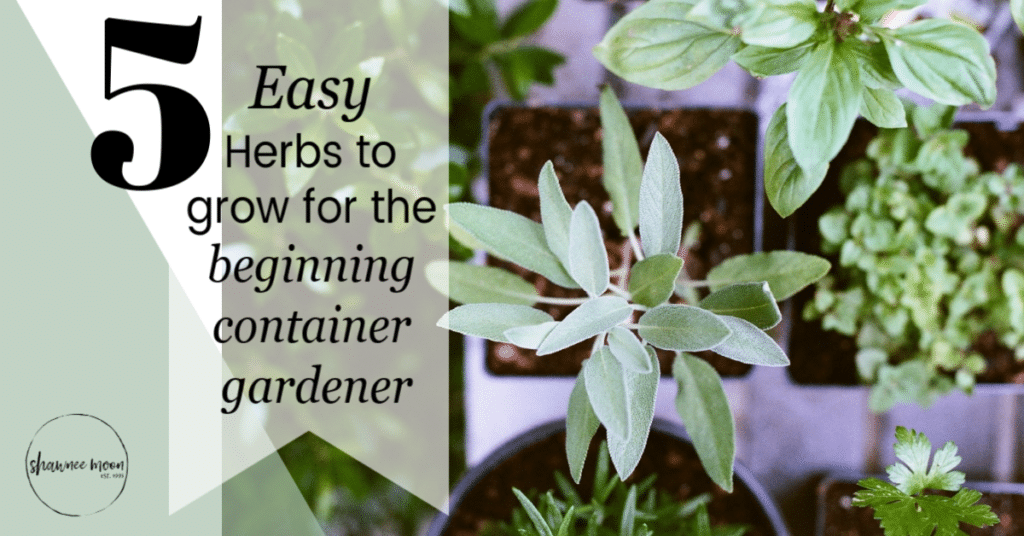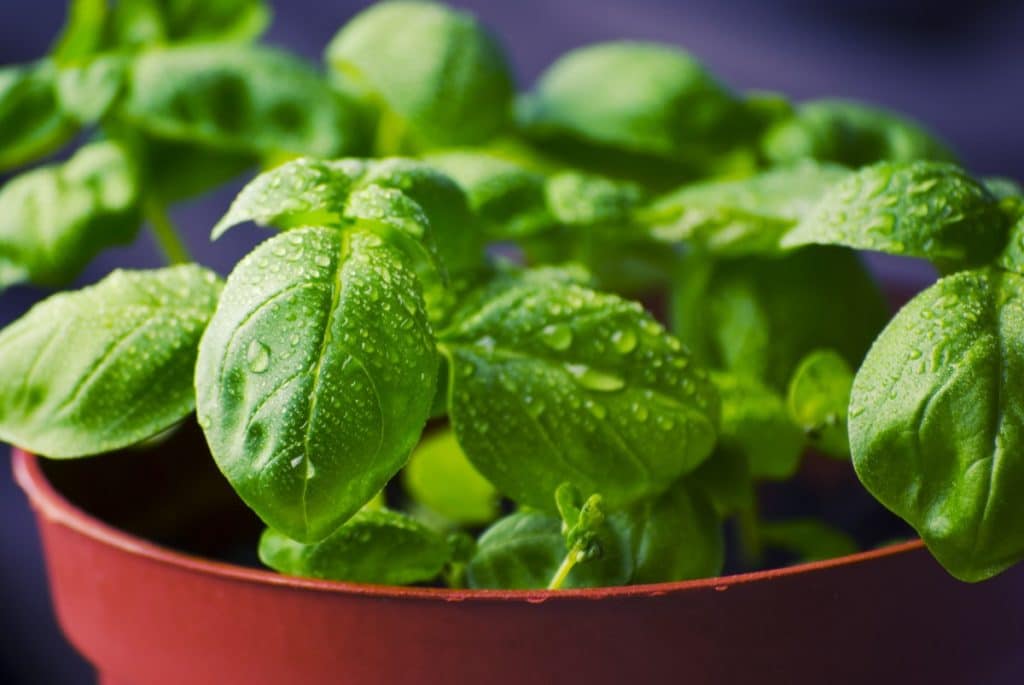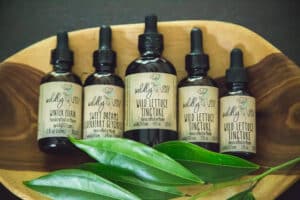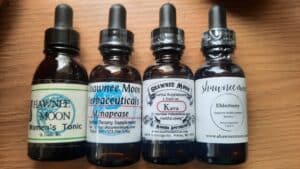
Last week I got this question, “What potted herbs would you recommend to a new gardener?” What a great question! I had so much I could say in response, but I thought I would create this post to include all my tips in one place that new gardeners could refer back to as needed!
Let’s talk dirt
Plants draw nutrients from the ground through their roots to produce a good structure with healthy fruit. With that understood, making sure you have a healthy potting soil with compost/natural fertilizer added to start your herbs off with is ideal.
I highly suggest avoiding potting soil with synthetic fertilizers or herbicides/pesticides already added in. These additives may be fine for plants that you are not ingesting, but as we already mentioned, plants will absorb trace amounts of these substances and then if you use these plants/herbs in your kitchen, you will then be absorbing trace amounts… Not ideal.
You might even want to just mix your own potting soil with compost, peat moss, and top soil. Just double check your getting ones that have no additives. This would likely even be cheaper than the fancy brand name dirts with toxic chemicals added. Win win.
Choosing containers for your herbs
There are many cute plant pots these days! You can buy inexpensive ones from dollar stores and cutesy them up with spray paint and punny sayings on top; or go all out for fancy, ready-made ceramic or terracotta pots from big box stores. Whatever suites your style, remember your space and some practical tips.
Make sure your pots have a drainage hole in the bottom. This is necessary to make sure your herbs don’t get root rot from being too soggy-bottomed. But note that when you do water, excess will drain out and could cause a mess, so consider grabbing a plant tray of some kind to catch the excess. Make sure you have some kind of course rock in the bottom of your pots so that the dirt doesn’t become compacted and clog your drain holes!
Consider your location and whether you will keep your herbs inside or out. Backyard patios or decks can be great places for potted herbs, but can often be sites that get loads of heat in summer, so you will want to make sure you water your container herbs every morning or late evening; possibly both in the hottest part of the summer.
Indoors, you can control the temperature better, but sunlight may be a problem. Typically, south facing windows are best for placing your potted herbs so they get the most direct light possible during the day. Indoor herb gardens can thrive well with enough light and not over watering.
Plants and pets
If you have pets, and plants, indoors be aware that many pets like to dig in fresh dirt (cats and dogs!). Keep an eye on the pets as you introduce new plants, cause you might end up with a mess on your hands. Consider plant stands that keep plants out of reach of curious critters.
Or, a decorative option could be putting your plant pot in a drawstring bag and drawing it up around the dirt hugging the stalk of the plant. It would make it a tad harder to water, and you may want to cut the bottom out of the bag so it didn’t soak up water from the drain holes, but it might keep kitties from scratching in the dirt like litter.

What herbs to start with?
There are many herbs that are very easy to grow and use in the kitchen. Some are even better suited being grown in pots than others, so you new gardener who is overwhelmed by the idea of growing in the ground, herbs are perfect for you!
Let’s jump right in to my list of the best/easiest potted herbs to grow for new gardeners:
1. Peppermint

As a perennial herb, meaning it comes back every year, Peppermint can actually over run your garden if you don’t keep it contained. It spreads by runner roots, so usually a large pot will keep it restrained. It will soon out grow your container but it doesn’t seem to mind getting a bit root bound, so if you don’t re-pot it right away you won’t have too many repercussions. These characteristics make it a great starter herb for newbie gardeners.
There are so many different types of mint plants, so you could have several pots with different varieties and have a whole mint garden. Check out the most popular types like, Apple mint, Chocolate Mint, Spearmint, and Pineapple Mint.
You can use peppermint leaves/stalks fresh in tea and other recipes. You can also harvest bunches and dry them then store to have mint when ever you need. Dried peppermint herb is found along with other spices in many Greek recipes. Iced Peppermint tea can be a life saver on hot summer days. Hot peppermint tea with chamomile and honey is perfect for evenings at home when you need to wind down. It stimulates digestive juices so it is great in supporting healthy digestion and calming butterflies in your stomach. (Check out peppermint products on Shawnee Moon)
2. Lemon Balm

Lemon balm is another perennial that will take over your garden if you turn your back. It is a great idea in a pot, but it can still spread to your yard as it is self-seeding. Meaning, after it blooms, it will drop seeds and they blow with the wind and the pollinators and will be all over. To avoid this, simply pinch back the blooms before they finish blooming so they can’t go to seed. Your original plant should still come back year after year.
Lemon balm fresh makes a great tea with an herby and lemony taste. When it is dried it has less of a lemon taste, but it is still useful herb to support health. It is great for calming, relieving occasional head tension, and supporting healthy sinuses. Try blending peppermint with lemon balm! (Check out lemon balm products from Shawnee Moon)
3. Basil

Since it is an annual, it won’t come back every year, but basil is beautiful and tasty and was a must to add to this list! Fresh basil is the best to use in the kitchen! It is so flavorful and easy to add to pastas, sandwiches, soups, pizzas, appetizers and salads! It always puts a dish over the top amazing when we add a fresh clove of garlic with a few fresh leaves of basil.
This herb is a native of the tropics, so it loves hot summers on the patio in a pot; just make sure to keep it well watered. The minute flower buds start coming on, pinch them off! This will force the plant to putting more effort into producing more leaves for your kitchen. (The only Shawnee Moon product that contains basil!)
4. Sage

Basil and Sage are some of my most used kitchen herbs (After Garlic!). Sage is an evergreen perennial sub-shrub, with woody stems and gorgeous gray-green leaves that stay on all winter. They drop their previous years leaves as new ones come on in the spring. They product beautiful purple spike flowers (similar to Lavender, only larger and a bluer-purple) but the majority of their scent is held in their soft, lamb-like, leaves.
Sage is a native of the Mediterranean, so it likes sandy/rocky soil that drains well and stays warm. Putting some white rock on top of the soil can help reflect light and heat onto the plant. Start this in a large pot, it doesn’t care for being disturbed by lots of re-potting. In it’s seconded or third year, prune the plant back by half in early spring (For zone 6 this is end of Feb – early Mar). An annual pruning is essential for a healthy Sage bush. If you have harsh winters, consider bringing your potted sage inside for the winter.
Pick off a few fresh leaves and rinse and chop them; add it to pasta and soups, meat dishes and stuffing. Fresh sage is glorious. It can also be found in some tea blends. Sage is traditionally associated with wisdom, ahem, ever heard of “Sage advice”? It is useful for healthy, normal, brain function. Sage is said to be a protective plant and often utilized in spiritual practices and mediation. I just love the way it smells! (Check out which Shawnee Moon products contain sage).
5. Oregano

5Another native to the temperate Southwestern Eurasia and the Mediterranean region, Oregano is a low growing plant, with small round leaves and purple flowers that grow from erect spikes. Again, a perennial, so expect it to come back every year with proper care.
Harvest the stems, rinse and de-leaf them for your recipes calling for oregano. Again, you can harvest bunches to dry and use as needed throughout the year for your favorite oregano recipes. (Check out the only product from Shawnee Moon containing oregano!)
Pro-tip: “How much fresh herb should I use when my recipe calls for dried?”
- Since dried herb is more condensed than fresh (fresh herb contains a lot of water), it is stronger than fresh and you will not need as much dried as you will fresh. In general, it’s about a 3 to 1: If a recipe calls for 1 teaspoon dried herb, use 3 teaspoons fresh herb. Or if a recipe calls for 1 Tablespoon fresh herb, you can usually use 1 teaspoon of dried (Since there are 3 teaspoons to 1 Tablespoon).
Plants or Seeds?
For the newbie gardener; I’d for sure suggest start with plants. The herbs I’ve mentioned above are very common and you should be able to find them at your local farmers market or nurseries in the spring.
Basil would be one that I’d say you could probably swing starting by seeds if you were feeling adventurous. Get the seeds started in your pots a good 6 weeks before the last frost for your area. Since you are reading this article you are probably intending to keep them in the containers you start them in, which is fine. I’d suggest 3-5 seeds in a 2″ pot, 4-8 seeds in 6″ pot, etc. It is okay to leave them clustered in the center and having more than one plant in a pot. Basil doesn’t mind snuggling, other plants may not thrive well that close, though.
Keep the dirt moist before they sprout, don’t let them dry out during germination. Then as soon as they sprout, it’s okay to let the dirt dry out some. At this point it is easy for your dirt/seeds to mold staying so moist at room temperature. To avoid this you could also keep a fan on them a few hours a day, to help dry them out, without completely leaving them parched and dying of thirst. It’s a balance!
A note on your perennial herbs
Most of the herbs I listed above are technically perennial; meaning they will come back every year. But, this can be different for different zones. And, keeping your perennial herbs in pots can change this too. If you have very harsh winters, your perennial plants might freeze over too easily in a pot (vs. if they were in the ground they would have more thermal mass to protect them in the extreme temps.).
One option for cold, northerly climates, is bringing your pots inside for the winter. They will likely thrive well over winter, and you can continue having fresh herbs all year. But they also may go into more of a dormancy state, and not grow much until you plop them back outside the next spring.
Trouble shooting
Any number of problems can (and will!) come up when you are gardening for the first time. The most important thing to remember?? You can always try again next year! Don’t be afraid to make mistakes and learn from them to do it better next time.
Gardening is full of a lot of elements that we just can’t control. It takes a lot of faith to grow a garden. Don’t be discouraged if it doesn’t turn out like you expect. Go with the flow and just see where it might take you.
With that said, there are a couple things to look out for.
- Watering too much – with container plants, this is the hardest thing to balance. Newbie gardeners are enthusiastic and can easily over water potted herbs (especially indoor plants). More often than not indoor plants are killed by over watering. Before you water, check the soil, is it dry or damp? Even if the top of the soil is dry, check the collector tray under the drain holes in your pot, it could be sitting in water, and the top be dry. The roots of your plant will get the water it needs if that’s the case.
- Watering not enough – On the other hand, since potted herbs don’t have much soil, they can also dry out very quickly (especially potted plants, outside, in full sun all day). If your potted soil is dry and cracked, and your plants are wilting in the heat, you definitely need more consistent watering. Consider moving them to a place where they get some reprieve from the sun (So maybe they get 4 hours full sun instead of 6-8 hrs). Water them twice a day (Still allowing proper drainage so you’re not over watering), not in the heat of the day. Watering the leaves of tender herbs in the heat of the day can really damage them. That water acts like a magnifying glass and can burn up your herbs.
- Go big, or go home – the size of your plants generally determine the size of the pots you put them in. If you buy plants that come in like a 4″ plastic pot, you will want to be putting them into a bigger pot, at least a 6″-8″ cause, if all goes according to plan, those babies are gonna grow. If you don’t want to have to re-pot them in three weeks (cause most plants will be happy if you do, every body likes a little wiggle room), size up, size up, size up. Get a Super big pot for your little plants, they get lots of soil, you won’t have to water as frequently cause the mass will stay moist longer, and you won’t have to re-pot til much later.
- Bugs – with most herbs, like those mentioned above, they are ‘aromatic’, and that is one reason why we love them so much. But also, that is their defense mechanism against buglets. Bugs don’t like the strong essential oil that wafts off the herbs when they are chomped into, or brushed up against, and will generally leave them alone. If you do happen to have a problem with bugs getting at your herbs, use your hose to power wash off any bugs that are currently attached to the plant. Then mix up some non-toxic soap (I use Thieves Household Cleaner) diluted in a spray bottle and soak the plant down with the soapy water and let it stay.
Pro-Tip:
- If you have aromatic herbs growing in pots on a patio/deck where you sit to enjoy the out doors, you can brush/pet/crush the leaves of your herbs till you smell the essential oil wafting and enjoy the benefits of the bugs leaving you alone in that space!
Other herbs you might consider growing

- Calendula – this is a flowering annual that is easy to grow from seed. The blossoms are edible and a relative of marigold and they grow easily in containers. Add flowering tops to salads! It is not too fragrant, but the flowers are very nutritive and calming to the skin. Add them to your next bath and your skin will thank you.
- Thyme – ain’t nobody got thyme for that! (Yes, that just happened). Anyway.. Thyme is a low growing, herbaceous plant with over 350 varieties! Many are simply ornamental as they have darling little blooms in all kinds of shades from pinks to blues, purples and whites. Thyme is a great kitchen spice that is found in all kinds of recipes from quiche to meat loaf and more.
- Chives – there are a few varieties to choose from, but the most popular are standard chives that have pink blooms. You should be able to find chive plants at your local nursery. They do well in a pot with average soil in full sun. They are perennial, so look for them to come back next year through zone 9. Also will do well indoors on your sill.
- Cilantro – is fairly easy to grow from seed in containers. Doesn’t thrive indoors, though. Plant early in the spring, outdoors, as it is a cool weather plant. Once the days get too warm (about 75 degrees F) the plants will ‘bolt’, meaning it will bloom and go to seed (and it does it ‘lightening bolt fast’). Once this happens, the leaves change flavor and are bitter. So, harvest leaves early (when plant is about 6″ high) and often (for 5-7 weeks) to get the most out of your annual cilantro crop. Enjoy fresh in salsa and guacamole and other Mexican dishes. Plant seeds again at the end of summer/beginning of fall as the weather starts to cool down and enjoy another harvest in fall. (about 12 weeks before first frost).
What are your favorite herbs to grow?
List your tips in the comments below! I know there are many more suggestions to be had for growing herbs for beginner container gardeners, so feel free to leave more info from your experience. We all have more to learn.
Join the conversation over at our closed FB group here. Request to be added and answer the questions for approval (we like keeping it personal and spammer free).
Thank you for reading and sharing!
Until next time, Kerry





